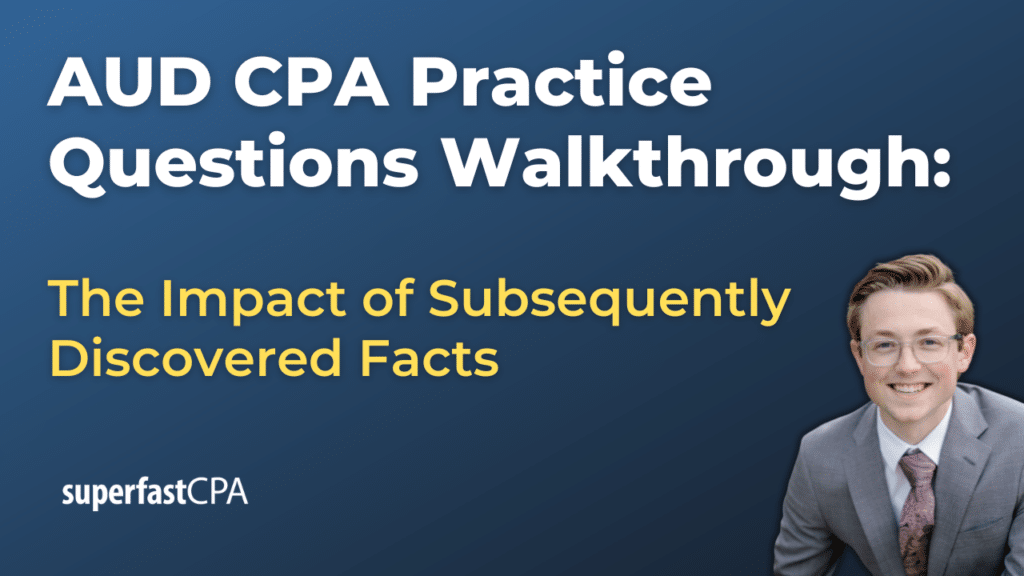In this video, we walk through 5 AUD practice questions teaching about the impact of subsequently discovered facts. These questions are from AUD content area 3 on the AICPA CPA exam blueprints: Performing Further Procedures and Obtaining Evidence
The best way to use this video is to pause each time we get to a new question in the video, and then make your own attempt at the question before watching us go through it.
Also be sure to watch one of our free webinars on the 6 “key ingredients” to an extremely effective & efficient CPA study process here…
The Impact of Subsequently Discovered Facts
When an auditor issues a report, the work does not always end there. Occasionally, information comes to light after the audit report date that, had it been known earlier, would have affected the report. This is referred to as a subsequently discovered fact.
We’ll cover what subsequently discovered facts are, how the auditor is expected to respond, what dating options are available for a revised report, and what steps to take if management refuses to act.
Definition of Subsequently Discovered Facts
Subsequently discovered facts refer to information that:
- Was not known to the auditor as of the date of the audit report, and
- Existed at that date and may have affected the report had it been known.
This concept differs from subsequent events, which are events that occur after the report date. A subsequently discovered fact relates to conditions or information that were already in existence but not identified during the audit process.
Example:
An audit report is dated March 1. On March 10, prior to the report release, the auditor becomes aware that a material legal liability existed as of year-end but was omitted from the financial statements. This information qualifies as a subsequently discovered fact.
Auditor Responsibilities Upon Discovery
If such a fact comes to the auditor’s attention, the auditor must:
- Discuss the matter with management and those charged with governance.
- Assess whether the information is reliable and whether it existed as of the auditor’s report date.
- Determine whether users of the financial statements would consider the information significant.
If the fact is determined to be both material and relevant, and it existed at the report date, the auditor may be required to revise the audit report.
Example:
If the fact involves the bankruptcy of a major customer as of the balance sheet date, and that customer represented a significant portion of receivables, this would likely be considered important by users.
Obligations After the Report Release Date
An auditor is not required to perform ongoing procedures after the audit report has been released. However, if a subsequently discovered fact becomes known after the report release date, and it would have affected the auditor’s report, the auditor is responsible for determining an appropriate course of action.
This may involve evaluating the need to revise the audit report and working with management to ensure that users are informed of the revised financial statements and opinion.
Dating a Revised Audit Report
If the audit report must be revised due to a subsequently discovered fact, the auditor has two options for dating the revised report:
Dual Dating
If the auditor performs additional procedures limited to the specific fact, dual dating may be used. In this case, the original date is retained for the remainder of the report, with a second date added to address the subsequently discovered fact.
Example:
“March 1, 20X5, except for Note 9, as to which the date is March 10, 20X5.”
This approach limits the auditor’s responsibility to the newly discovered fact as of the later date.
Single New Date
If the auditor performs additional procedures that are not limited to the specific fact, the entire audit report must be redated using a new single date. This implies that the auditor extended audit procedures through the new date.
Example:
The audit report is redated entirely to March 10, 20X5.
When Management Refuses to Revise the Financial Statements
If the auditor concludes that the financial statements should be revised but management refuses to take appropriate action, the auditor should consider:
- Notifying users that the auditor’s report should no longer be relied upon.
- Informing regulatory agencies, if applicable.
- Seeking legal counsel.
- Withdrawing from the engagement, if necessary.
The auditor’s responsibility in this situation is to protect users from relying on materially misstated financial statements.
Key Points to Remember
- A subsequently discovered fact must have existed at the date of the audit report and be material to users.
- The auditor must evaluate the fact and determine whether it requires revision of the report.
- There is no continuing obligation to perform procedures after the report release date unless such a fact becomes known.
- If revision is necessary, the auditor may use dual dating or redating, depending on the scope of additional procedures performed.
- If management refuses to act, the auditor may need to take further steps to alert users or regulatory bodies.













